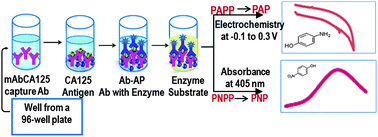Dual detection of cancer biomarker CA125 using absorbance and electrochemical methods
Abstract
An enzyme-linked immunoassay based on dual signal transduction mechanisms has been developed for detection of ovarian cancer biomarker CA125. The immunoassay uses a nanoelectrode array (NEA) chip and absorbance methods for the dual detection. The NEA is used to confirm the optical detection of CA125 that is carried out in a high-binding 96-well plate. An alkaline phosphatase (AP) enzyme was used to label the detection antibody to allow for both the optical and electrochemical detection of CA125. Two kinds of substrates were catalyzed by the AP enzyme. para-Nitrophenylphosphate (PNPP) produces chromogenic para-nitrophenol (PNP), which can be optically detected at 405 nm. para-Aminophenylphosphate (PAPP) produces electroactive para-aminophenol (PAP), which can be detected amperometrically between −0.1 and 0.3 V. The linear ranges have been determined to be 5–1000 U mL−1 and 5–1000 U mL−1 for the optical and electrochemical immunoassays, respectively. The limit of detection of the optical immunoassay is 1.3 U mL−1 and 40 U mL−1 for the optical and electrochemical methods, respectively.


 Please wait while we load your content...
Please wait while we load your content...